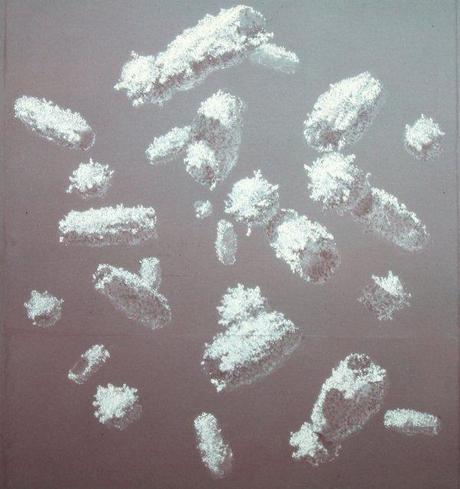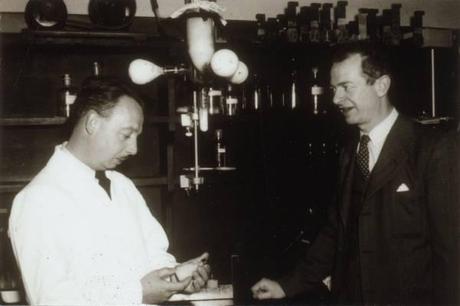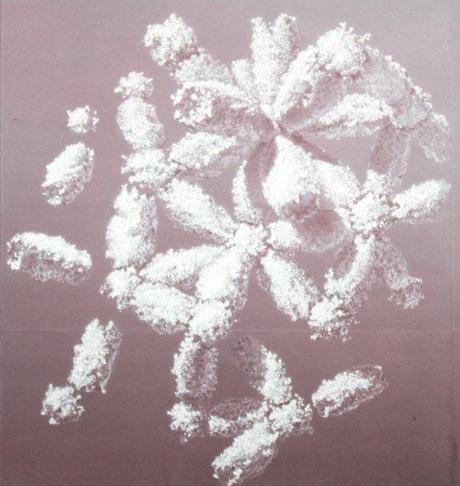
Illustration of bivalent antibodies attaching to complementary antigen molecules. Image extracted from a glass plate display, “Pictures of Antibodies,” prepared for the First International Poliomyelitis Conference, New York. The caption accompanying this image reads: “In vitro or in vivo bivalent antibodies may become attached to complementary portions of antigen molcules.”
[Part 3 of 3]
Though highly controversial, Linus Pauling’s claim that he had created artificial antibodies gave him a boost in funding. Many of his backers realized that if Pauling was correct he had just revolutionized modern medicine and they were just as eager as he was for his project to succeed. Since he now had more money, Pauling hoped he could expand his staff, though the war greatly prohibited this effort. Pauling lamented:
Unfortunately the amount of war work which is being done now here is so great that the usual seminars and informal discussions of science have decreased somewhat in number, but still a good bit of work in pure science is being carried on.
To help remedy this situation, Pauling corresponded frequently with William C. Boyd of Boston University’s School of Medicine, trying to persuade him to transfer to Caltech over the summer. Boyd refused, stating that he had too many other medical defense projects, though suggesting that “perhaps it will not be too late when the war is over, unless it goes on for 10 years or more, as some pessimistic writers predict.” Pauling also failed to hire two other well-known researchers, Henry F. Treffers, and A.M. Pappenheimer. Both declined because he was only able to offer a one year position. Indeed, from 1942-1943, Pauling actively tried to find staff for his lab, offering a $3,500 one-year position and draft deference. Despite this, most of the competent researchers he wanted were otherwise employed doing war work. He was able to hire Leland H. Pence in December of 1942, and in 1945 Frank Johnson visited from Princeton and worked at the lab in Caltech a bit. These individuals were, however, the exceptions, and Pauling was generally unsuccessful with his offers of employment.
Pauling was also facing other staff issues that were relics of the era. Among his group were two employees who were born and raised in the United States, but whose families were Japanese, Carol Ikeda and Miyoshi Ikawa. All too cognizant of the forthcoming policy of internment, Pauling began corresponding with Michael Heidelberg of Columbia University, hoping that he could temporarily trade employees as a method of getting Ikeda, at least, to a less hostile location. The plan did not work out, and Heidelberger ended one of his letters to Pauling bemoaning the fact that “…unfortunately a lot of wholly patriotic people are going to suffer.” Pauling was eventually able to get both Ikeda and Ikawa into graduate programs, though doing so took a substantial amount of work.

Dan Campbell and Linus Pauling, 1943.
Even though William Boyd had refused a job, he and Pauling continued to correspond frequently. Boyd was critical of Pauling’s theories on antibodies, warning his colleague that “preconceived notions evidently play a big role in the field [of immunochemistry.]” Boyd told Pauling to be careful with his research and his declarations, as he had often made arguments that he felt infallible only to have his colleagues inform him that they were unconvinced.
In August 1942, five months after issuing his controversial press release, Pauling finally published his research on artificial antibodies in an article titled “The Manufacture of Antibodies in vitro,” which appeared in the Journal of Experimental Medicine. As with the press release, Pauling’s paper was somewhat lacking in detail and many scientists found it hard to replicate his experiments. Those who did, such as Pauling’s valued colleague Karl Landsteiner, were unable to obtain the same results that Pauling had reported. Despite this, Pauling remained convinced that his research was valid and worth pursuing. However, Pauling’s collaborator Dan Campbell seemed to be the only one who could successfully produce the antibodies, and even those were weak and ineffective.
In early 1943 the Rockefeller Foundation assigned Frank Blair Hanson to assume some of the work that Warren Weaver had been conducting, and right away it was clear that Hanson was notably “less entranced than Weaver with Pauling’s work.” Despite the fact that he agreed to continue funding Pauling’s artificial antibody research, he was skeptical of its worth and began polling immunologists across the country to that end. They did not respond favorably – even Landsteiner believed that there was a less than 50% chance that Pauling had actually created artificial antibodies. As a result of these lackluster opinions, Hanson cut Pauling’s funding by half.
Pauling proceeded nonetheless, his enthusiasm still strong. His next move was to submit a patent application, “Process of Producing Antibodies.” The response that he received was not what he wanted to hear:
The claims are again rejected for lack of utility as no evidence has been presented to show that the antibodies alleged to be produced by the claimed have any utility at all… The claims are rejected as being too broad, functional, and indefinite…the claims are rejected for lack of invention…all the claims are rejected.
Pauling was disheartened by this response but still confident that he could salvage the project. However, shortly afterward he received a letter from the Rockefeller Foundation informing him that they did not approve of researchers using their funds to apply for medical patents. Because of the letter, and the general ineffectiveness of the research, Pauling opted not to pursue his patent application any further.

Illustration of the antibody-antigen framework. The caption accompanying this image reads: “…[An] antibody-antigen framework which may precipitate from a solution or be taken up by phagocytic cells.”
Physiological ReviewBy the winter of 1943-1944, Pauling had at last concluded that the artificial antibody research was going nowhere. This was a difficult admission for Pauling because, despite the fact that progress in the research was still slow, he was convinced that he could make it work if given more time. Unfortunately for him, the war effort demanded quicker results and actively prohibited greater focus on antibodies. In the end, he decided to abandon the artificial antibodies research. Pauling never retracted his support for the work, though many years later Dan Campbell admitted that a laboratory technician had “shaded” the results to fit what he thought Pauling wanted to see.
The failure of the artificial antibodies project allowed Pauling to move on to more productive lines of research. He continued to build his ideas on how exactly antibodies function, and by 1945 he was able to prove that shape was indeed what caused antibodies to adhere to antigens. In Pauling’s description, the antibodies would fit to the antigens like a glove, at which point they adhered, not due to orthodox chemical bonds, but because of another weak, poorly understood force.
The force that causes antibodies to bind with antigens is called the van der Waal’s force. It is a very weak, almost imperceptible subatomic bond between two molecules existing in extremely close proximity. Historically, due to their weakness, van der Waal’s forces had been ignored as viable components of biochemical reactions. However, Pauling was able to show that the extremely tight fit between antibodies and antigens exposed a large surface area across which the van der Waal’s force could become a factor. The fit had to be precise, as even one or two atoms being out of place would effectively break the hold that the van der Waal’s force put into place. This concept, known variously as molecular complementarity or biological specificity, cast a great deal of light on a central mystery of molecular biology. With it, Pauling was additionally able to confirm his earlier hypothesis that antibodies are bivalent.
As World War II drew to a close, Pauling shifted his focus away from antibodies and back towards a more general study of the shape, creation, and function of proteins. Pauling’s focus on proteins was long lived, stretching at least twenty-five years from 1933-1958. His foray into antibodies was notably shorter, a nine-year interlude from 1936-1945. Yet in this time, he had managed to dramatically impact immunochemistry with his discovery that antibodies are bivalent and his insights into how they work. These accomplishments are made even more impressive when considering that Pauling was neither an immunochemist nor an immunobiologist by trade. As was so often the case during his life, he threw himself into the challenge with characteristic enthusiasm, and managed to make major contributions to the field.
